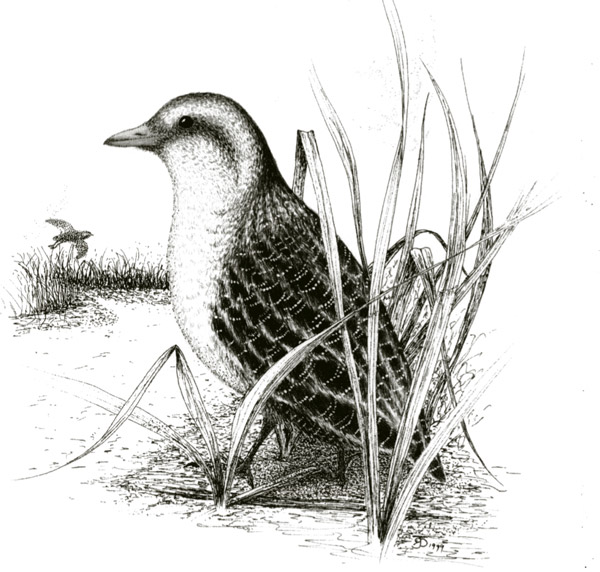|
Yellow Rail in Carden
Ron Pittaway |
|
|
|
First published in
the Toronto Ornithological Club Newsletter, May 2018, Number 277 |
|
 |
|
Yellow Rail illustration by Ross D. James |
|
Introduction:
The Yellow Rail is one of North America’s most elusive and
sought-after birds. The Sedge Wren Marsh along Wylie Road on the
Carden Alvar is the most reliable place in southern Ontario to hear
Yellow Rails in spring. Below are tips and
background information to help birders hear and appreciate Yellow
Rails. |
|
|
|
Occurrence:
The first record of a Yellow Rail for the Carden Alvar was one heard
in May 1991 at the Sedge Wren Marsh. It is now almost annual at the
marsh from late April to late May. The earliest record is 27 April
2003. One evening in May, Jean Iron and I heard Yellow Rails at
three locations in Carden: Sedge Wren Marsh, Prospect Marsh and
Cranberry Lake. In years of high water levels, it is heard less
often or goes unrecorded. These Yellow Rails are migrants presumably
going to the coastal marshes of James and Hudson Bays where they
arrive in June. |
|
|
|
Habitat:
Yellow Rails require damp or shallow sedge/grass marshes
with little or no standing water, and having a canopy of dead
vegetation from previous years. Rarely seen, the rails usually sing
and move hidden under the thatch layer. The Yellow Rail’s need for
shallow grassy marshes and its narrow tolerance of water level
changes make it a habitat specialist. A wetland may be suitable one
year, but too wet or too dry the next year. Water levels were high
in Carden in 2017 and no Yellow Rails were reported. |
|
|
|
Song:
Male Yellow Rails
utter a rapid 5-note clicking tic-tic, tic-tic-tic
song sounding like two stones or quarters being tapped together.
They are vocal from just before sunset, often all night, early
morning, and sometimes on overcast days.
Its ticking can be confused with the kid-ick, kid-ick,
kid-ick song of the male Virginia Rail. Listen to a Yellow Rail
ticking in Carden and see its spring habitat in Jean Iron’s video.
https://bit.ly/2qc2M9g |
|
|
|
Breeding:
The Yellow Rail has never been found breeding in Carden. It was
mapped there as a possible breeder during the second breeding bird
atlas 2000-2005 (Tozer 2007). Breeding Yellow Rails are very vocal
in June and July, so suspect nesting only if singing is heard over
an extended period of time in summer. Historically, it nested nearby
at the vast Holland River Marsh which flows into Cook’s Bay, Lake
Simcoe. On 12 June 1938, TOC members Ott Devitt and Dick Ussher
found the first nest and eggs for Canada near Bradford in Simcoe
County (Devitt 1939). Hugh Currie, Herb Elliott and Alvaro Jaramillo
heard and saw one near Bradford in Simcoe County on 29 May 1981. It
occurred in both the Simcoe and York portions of the Holland Marsh (Devitt
1967). The Yellow Rail was found at the Holland Marsh during the
first atlas 1980-1985, but not detected there in the second atlas
2000-2005. Much of the marsh was drained long ago for market
gardens. |
|
|
|
Special Concern:
About 90% of the Yellow Rail’s breeding range is in
Canada
and the estimated Canadian breeding population is
around
5,000 pairs (Environment
Canada 2013).
The Yellow Rail is designated a species of Special Concern by
the Committee on the Status of Endangered Wildlife in Canada (COSEWIC)
and by the province of Ontario. Special Concern is a species
that may become Threatened or Endangered. The TOC
follows OFO’s Code of Ethics which states: “Limit
the use of playbacks or other methods of attracting birds. Never use
such methods in heavily birded areas, or for attracting any species
that is Endangered, Threatened or of Special
Concern, or is rare in your local area.” |
|
|
|
Night Listening:
Experience an evening adventure of songs and calls in May at the
Sedge Wren Marsh. You could hear a Yellow Rail plus Sora, Virginia
Rail, American Bittern, Sedge Wren, Ruffed Grouse, American
Woodcock, Sandhill Crane, Eastern Whip-poor-will, and Common
Nighthawk. |
|
|
|
Acknowledgements:
I thank Glenn Coady, Hugh Currie and Joan Winearls
for historical information. |
|
|
|
References |
|
|
|
Devitt, O.E. 1939. The Yellow Rail breeding in
Ontario. Auk 56:238-243. |
|
|
|
Devitt, O.E. 1967. The Birds of Simcoe County,
Ontario. Brereton Field Naturalists’ Club, Barrie. |
|
|
|
Environment Canada. 2013. Management
Plan for the Yellow Rail. (Coturnicops noveboracensis) in
Canada. Species at Risk Act Management Plan Series. Environment
Canada. Ottawa. |
|
|
|
Tozer, D.C. 2007. Yellow Rail in
M.D. Cadman, D.A. Sutherland, G.G. Beck, D. Lepage and A.R.
Couturier, (Eds.). Atlas of the Breeding Birds of Ontario
2000-2005. Bird Studies Canada. Environment Canada, Ontario
Field Ornithologists, Ontario Ministry of Natural Resources, and
Ontario Nature. |
|
|
|
For more information
Please see Ron Pittaway's Carden
Alvar Birding Guide |
|
|
|
|